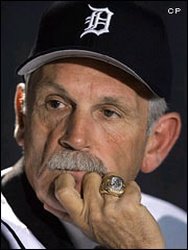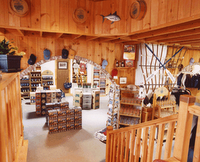I've been drinking, and of course sitting here reflecting on the way the meaning of the phrase "beer fueled weekend" has gradually shifted in my personal lexicon over the past few years. Where once the phrase carried connotations of a man so drunk he is punching his friend in the face to wake him up because he is passed out on the couch in his dorm-suite lounge and he needs to wake up and walk the fifteen feet to his bead, it now carries the image of a man driving all over the mid-west in search of a good hike, a little dose of knowlege from a friendly brewer or two, and of course a good pint of beer.
Suffice it to say, that when I write here that my last two-weekends have centered on beer fueled jaunts, I am not about to reel off a story of complete debauchery, which I suppose means there really is no point in wiiting about them at all. But since I was raised an evengelical Christian, and I know that it is truly blessed to speak more loudly and piously about you religion at times people will care the least, I feel no choice but to press on and spread the word of my new religion, Mid-Western beer.
First up is Flossmoor, IL, home of the Flossmoor Station Brewing Co., I first became aware of Flossmoor last spring during Beer on the Pier, a beer tasting event held on Chicago's Navy Pier and featuring tasty brews from all over the mid-west. Flossmoor was one of the smallest breweries there, sharing a table with a snooty-beer vendor specializing in imported belgium ales and another small brewery from Grand Rapids, MI. But what Flossmoor lacked in stature, It's featured IPA, more than made up for in bold-hoppy flavor and good crips finish. Had we been the judges, I and my three friends, a scotch-drinker, a stout-drinker and a non-drinker, would have unanimously voted the IPA best in show. Perhaps the highlight of the show was when I kept filling out extra-tickets to win a "I got de-railed at Flossmoor Station T-Shirt", size large, and I after I won, and announced there was no way I could wear this, having some 400 pound dude offer me $10.00 for it so he could give it to his 300lb girlfriend. I wanted fifteen but Icouldn't budge him, so I wandered back out into the city firmly resolving to visit Flossmoor if I ever got the chance.
Two weeks ago that chance finally game, a beautiful fall Saturday with nary an entertaning college football game on the slate, and so it was that after a short excursion to the wilds of the Medwine National Prarie and a harrowing experience with some evil looking bugs, I found my self making the short drive from Joliet over to Flossmoor more than ready for another taste of that heavenly IPA.
The brew pub itslelf is nestled in the heart of a mid-western suburban, and while it wasn't hard to find, it certainly was a kick to find myself driving past cul-de-sacs and down curvy tree lined streets confronting the ghosts of my childhood. When I finally emerged from my own haunted thrill ride, there was Flossmoor station right off the Metra commuter tracks, occupying an old remodeled train station. I was so excited to get to the beer, that I unwittingly charged up the first-set of stairs I found, across the beer garden and a backroom that was hosting a private party and directly to the bar where I promptly demanded the sampler.
While I was waiting for the sampler, I finally got around to reading the beer list, and my heart nearly sank to my shoes when I saw that the IPA was not currently on tap. The dissapontment was short lived however, when the bar tender arrived with my sampler tray of 12 four ounce glasses of beer. I will save you the touble of detailing my experiences with each different beer, all of which you can read about here, and just say that I dived in whole-heartedly only half worrying about having to still drive some 30-miles back to Chicago.
Maybe it was the fact that months of anticipation had led me to hold Flossmoor to unreal expectations, or maybe it was because I was tired and still a little hungover when I started drinking, but whatever it was, right off the bat, I was more than a little disappointed. The first few beers I drank just didn't seem to have any sort of distinguishing character or style, and that's not counting the Zephyr Light, which I had already written off as the annoying substitute beer all brewries out here seem to have for the frat girls who walk in and insist that they only like Miller Lite.
It was somewhat shocking for the Station Master Wheat to not immediately hit the spot on a hot day, and while the raspberry and cherry ales certainly held their own as curiosities, they did nothing to distinguish themselves from other fruit beers. There was a seasonal nut brown that I liked right from the stout, but on intial tasting the Pullman Porter had that sort of metallic-coffee taste that a not quite perfect porter sometimes acquires.
After about 20-minutes of sampling, I was watching the toy train traveling in circles above the bar and back behind the brauhaus and contemplating the best way to kick myself on a barstool for ruining my own personal myth of Flossmoor. I noticed that I hadn't touched the Panama Red Limited and half-heartedly lifted it to my lips. In an instant a star was born and things started looking up. It isn't often that one finds a red ale infused with nine types of malts and four types of hops all perfectly balanced. It was all I could do not to chug it all down, but there was still more to try, and now that there had been some time for them to breathe a few more of the brews started to come alive.
As I made my way through round number two of the Sampler the flavor of the Iron Horse Stout was finally beginning to build some momentum as it chugged down my throat, warming my body with a hearty roasted malt taste, and the Pullman Porter certainly did a good job of carrying away the baggage it had deposited only a few minutes before. But the hidden gem out of all of these brews was the aptly named Gandy Dancer Honey Ale, an American Pale Ale infused with honey that literally dances on your taste-buds.
30-minutes later, after a nother full pint of the Gandy Dancer had lightened my fee even more, I floated out of Flossmoor, firmly resolved that soon I would be bringing a group down on the train, and so excited about the growler of Panama Red I was carrying home, that I forgot all about checking my directions and ended up on a 35-minute detour that carried me east to Indiana and back west again before I finally got myself back on the right tracks.
I had been derailed at Flossmoor, and the trip couldn't have been better.
























